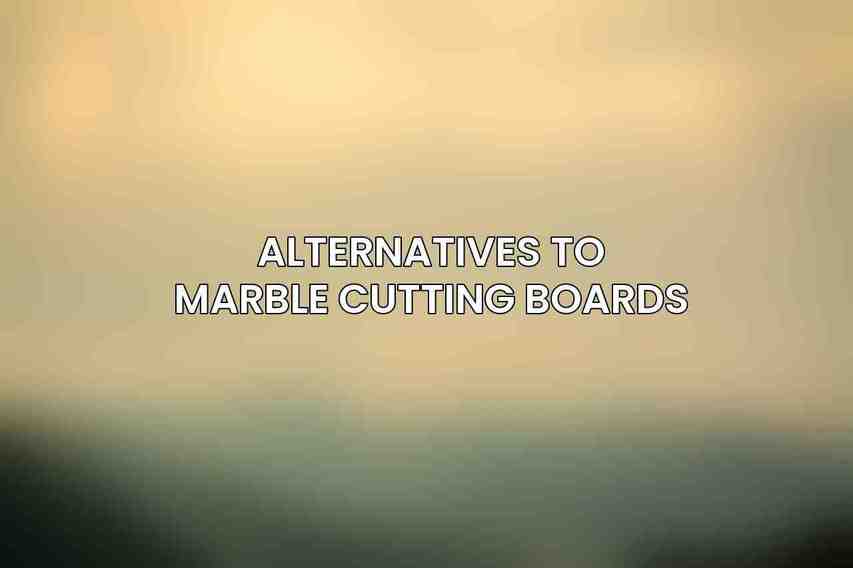Marble cutting boards are revered for their exquisite beauty and functional benefits in the kitchen. The allure of marble lies in its natural elegance and durability, making it a sought-after choice for both amateur cooks and culinary enthusiasts alike. When considering the use of marble cutting boards, factors such as porosity, hardness, and cost come into play, influencing the decision-making process for many home cooks.
| Cutting Boards | Description | Price | Link |
|---|---|---|---|
Marble Cutting Board, Large |
A large, elegant marble cutting board perfect for preparing meals. | Link to product page | |
Small Marble Cutting Board |
A smaller, more compact marble cutting board ideal for serving cheese or charcuterie. | Link to product page | |
Marble Cutting Board with Handle |
A marble cutting board with a convenient handle for easy transport. | Link to product page | |
Marble Cutting Board Set |
A set of marble cutting boards in different sizes, perfect for a variety of culinary tasks. | Link to product page | |
Marble Cutting Board with Groove |
A marble cutting board with a groove around the edge to catch juices. | Link to product page |
Quick List :
- 1. Marble Type::
- 2. Wood Cutting Boards::
- 3. Plastic Cutting Boards::
- 4. Bamboo Cutting Boards::
- 5. Marble Cutting Boards: Elegant and Functional:
The Appeal of Marble Cutting Boards:
- Aesthetic Appeal: Marble’s innate charm and opulent texture bring a touch of sophistication to any kitchen space.
- Durability: With its resistance to scratches and heat, marble stands the test of time, ensuring longevity in kitchen essentials.
- Cool Surface: The cool touch of marble not only aids in preventing food from sticking but also provides a steady platform for various culinary tasks.
Considerations for Using Marble Cutting Boards:
- Porosity: Due to its porous nature, marble can absorb liquids and stains, necessitating meticulous upkeep.
- Hardness: While sturdy, marble is susceptible to chipping or cracking under excessive pressure.
- Cost: It’s essential to acknowledge that marble cutting boards often come at a higher price point compared to other materials.
Benefits of Marble Cutting Boards
Embracing marble cutting boards in your kitchen brings forth a multitude of advantages that contribute to an enhanced cooking experience.
Stunning Visual Appeal:
- Natural Variations: Each piece of marble boasts unique veining and patterns, adding a touch of exclusivity to your culinary space.
- Classic Elegance: The timeless allure of marble elevates the aesthetics of any kitchen, exuding a sense of refinement and class.
Durability and Longevity:
- Scratch Resistance: Its hardness provides excellent resistance to knife marks and scratches, ensuring a pristine surface.
- Heat Resistance: Marble’s tolerance for high temperatures makes it ideal for serving hot dishes.
- Long Lifespan: With proper care and maintenance, marble cutting boards can last for generations, becoming a cherished kitchen heirloom.
Food Safety and Hygiene:
- Non-Porous Surface: When appropriately sealed, marble resists the absorption of liquids and bacteria, promoting a hygienic food preparation environment.
- Easy to Clean: The smooth surface of marble facilitates effortless cleaning with a simple wipe-down, maintaining impeccable hygiene standards.
Enhanced Culinary Experience:
- Cool Surface: The naturally cool temperature of marble aids in keeping ingredients fresh and prevents food from adhering to the board.
- Stable Work Surface: Providing a sturdy and level workspace, marble ensures precision in chopping and meal preparation.
Continue reading to explore the drawbacks of marble cutting boards and how to select the perfect marble cutting board for your kitchen needs.
For further insights, continue reading about how to properly care for your marble cutting board, the different types of marble, and alternatives to consider when exploring cutting board options.
Drawbacks of Marble Cutting Boards
While marble cutting boards offer numerous benefits, it’s essential to address their potential drawbacks to make an informed decision when selecting kitchen tools.
Porosity and Staining:
- Absorption: Marble’s tendency to absorb liquids, especially acidic substances, can lead to staining without proper care.
- Regular Sealing: Ongoing maintenance, including regular sealing, is essential to safeguard the pristine appearance of marble cutting boards.
Fragility and Chipping:
- Hardness: Despite its durability, marble remains vulnerable to chipping and cracking if subjected to forceful impacts.
- Impact Resistance: To preserve the integrity of your marble cutting board, exercise caution and avoid rough handling or dropping heavy objects.
Cost and Maintenance:
- Price Point: The initial investment required for a marble cutting board is often higher compared to alternative materials.
- Maintenance Requirements: Upholding the condition of a marble cutting board entails regular sealing and delicate handling to ensure its longevity.
Choosing the Right Marble Cutting Board
Selecting the perfect marble cutting board involves considerations like size, shape, thickness, finish, features, and the type of marble used in its construction.
Size and Shape:
- Size: Opt for a board that aligns with your kitchen’s requirements and available workspace.
- Shape: Choose from classic shapes like rectangle, square, or round to suit your culinary preferences.
Thickness:
- Stability: Thicker boards offer enhanced stability and are less prone to warping over time.
- Weight: Consider the weight of the board in correlation to your comfort level during food preparation tasks.
Finish:
- Polished: A polished finish provides a sleek and smooth surface for effortless meal prep.
- Matte: For a more textured appearance, a matte finish offers a rustic charm to your kitchen decor.
Features:
- Juice Grooves: Incorporate channels for collecting juices, minimizing messes during food preparation.
- Handles: Opt for cutting boards with handles for convenient maneuverability around the kitchen.
Marble Type:
- Carrara Marble: Renowned for its white base and delicate gray veining, Carrara marble exudes timeless elegance. Carrara Marble Cutting Board
- Calacatta Marble: Characterized by bold gray veining on a white backdrop, Calacatta marble embodies luxury and sophistication. Calacatta Marble Cutting Board
- Statuary Marble: With fine gray veining on a white surface, Statuary marble exudes a refined and elegant aesthetic. Statuary Marble Cutting Board
Continue reading to discover essential care and maintenance tips for your marble cutting board to ensure its longevity and optimal performance.
Explore the care and maintenance practices required to preserve the beauty and functionality of your marble cutting board, alongside alternatives to consider in the realm of cutting board options.
Care and Maintenance
Proper maintenance practices are crucial for preserving the pristine condition of your marble cutting board and ensuring its durability in the kitchen environment.
Cleaning:
- Wipe Down: After each use, gently wipe the surface of the marble cutting board with a damp cloth to remove any food residue.
- Avoid Abrasives: Refrain from using abrasive cleaners, harsh scouring pads, or bleach, as they can damage the marble surface.
- Dry Thoroughly: To prevent water damage and staining, always ensure the board is thoroughly dried after cleaning.
Sealing:
- Frequency: Seal the marble cutting board every 3-6 months or as needed to maintain its protective layer.
- Sealing Products: Utilize food-safe sealants specifically formulated for marble surfaces to ensure effective protection against liquid absorption.
Storage:
- Dry Environment: Store the marble cutting board in a dry area away from moisture to prevent any undesirable effects on the material.
- Separate Storage: To avoid potential scratches and damage, store the marble cutting board separately from other cutting boards and kitchen tools.
Alternatives to Marble Cutting Boards

While marble cutting boards offer a blend of elegance and functionality, exploring alternative options can provide insights into different materials suited to varying kitchen preferences.
Wood Cutting Boards:
- Warm and Natural: Wood cutting boards offer a natural and inviting aesthetic to your kitchen space.
- Variety of Woods: Choose from diverse wood types like bamboo, maple, or walnut, each imbuing a unique character to your culinary setup. Best Cutting Boards
Plastic Cutting Boards:
- Affordable and Durable: Plastic cutting boards serve as a cost-effective and resilient alternative to marble boards.
- Easy to Clean: With effortless sanitation properties, plastic cutting boards facilitate convenient cleaning routines. Plastic Cutting Boards
Bamboo Cutting Boards:
- Sustainable and Eco-Friendly: Bamboo cutting boards present an environmentally conscious choice, being sourced from a rapidly renewable material.
- Lightweight and Durable: The lightweight yet durable nature of bamboo boards ensures longevity and resistance to scratches and stains. Bamboo Cutting Boards
Marble cutting boards epitomize the perfect blend of elegance, durability, and practicality in the culinary realm. While they require attentive maintenance due to their unique characteristics, the beauty and functionality they bring to the kitchen are unparalleled. By understanding the advantages and considerations associated with marble cutting boards, you can make an educated decision on whether they align with your cooking preferences and aesthetic tastes.
Explore the range of benefits, drawbacks, care tips, and selection criteria for marble cutting boards to enhance your culinary experience and elevate the aesthetics of your kitchen space. Additionally, delve into alternatives like wood, plastic, and bamboo cutting boards for a comprehensive understanding of cutting board options available in the market.
Frequently Asked Questions
Are marble cutting boards durable?
Yes, marble cutting boards are known for their durability and resistance to wear and tear.
Are marble cutting boards easy to clean?
Yes, marble cutting boards are relatively easy to clean – simply wash with warm, soapy water and dry thoroughly after each use.
Will marble cutting boards dull knives?
Marble cutting boards are softer than other materials like glass or plastic, so they are less likely to dull knives when used properly.
Dive deeper into Best Wood For Cutting Board: Top Choices Explained
How should I care for my marble cutting board?
To maintain the beauty of your marble cutting board, avoid cutting acidic foods directly on the surface, clean spills immediately, and periodically treat it with food-safe mineral oil.
Can I use marble cutting boards for serving food?
Yes, marble cutting boards can also be used as elegant serving platters for cheeses, fruits, and other snacks, adding a touch of sophistication to your table setting.

